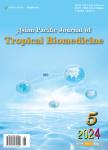Chromatographic fingerprinting and free-radical scavenging activity of ethanol extracts of Muntingia calabura L. leaves and stems
Chromatographic fingerprinting and free-radical scavenging activity of ethanol extracts of Muntingia calabura L. leaves and stems作者机构:Biological Research and Services LaboratoryNatural Sciences Research InstituteUniversity of the PhilippinesDilimanQuezon City 1101Philippines Institute of BiologyUniversity of the PhilippinesDilimanQuezon City 1101Philippines
出 版 物:《Asian Pacific Journal of Tropical Biomedicine》 (亚太热带生物医学杂志(英文版))
年 卷 期:2017年第7卷第2期
页 面:139-143页
核心收录:
学科分类:1008[医学-中药学(可授医学、理学学位)] 1006[医学-中西医结合] 100602[医学-中西医结合临床] 10[医学]
基 金:Supported by the Office of the Vice-Chancellor for Research and Development for the Outright Research Grant(Project No.151516 PNSE) the University of the Philippines Diliman
主 题:Muntingia calabura Antioxidant DPPH Thin-layer chromatography Secondary metabolites
摘 要:Objective: To determine the thin-layer chromatography(TLC) fingerprint profiles and to evaluate the in vitro antioxidant activity of ethanol extracts of Muntingia calabura(M. calabura) leaves and ***: The leaves and stems were extracted using ethanol as solvent. The TLC separation of the phytochemical constituents of the leaf and ethanol extracts was carried out in ethyl acetate: n-hexane and chloroform: ethyl acetate mobile phase *** spots were visualized under visible light, UV 254 nm, UV 366 nm and after spraying with vanillin-sulfuric acid. The 2,2-diphenyl-1-picrylhydrazyl free-radical scavenging assay was used to evaluate the antioxidant activity of the ***: Both the leaf and stem ethanol extracts at 4 mg/mL exhibited 2,2-diphenyl-1-picrylhydrazyl inhibition of more than 90%, relative to gallic acid. The results of TLC showed that the degree of resolution between the constituent spots was comparable between the two mobile phase systems using the different visualization wavelengths. Under the 254 nm visualization, few spots were observed in leaf and stem extracts. Visualization at 366 nm yielded the greatest number of observable spots of various colors in both leaf and stem extracts. More spots were visualized upon post-derivatization with vanillinsulfuric acid in the TLC chromatograms using chloroform: ethyl acetate mobile phase,compared to those in ethyl acetate: n-hexane mobile ***: M. calabura exhibited very high antioxidant activity in its leaves and stems ethanol extracts, both of which are used in traditional medicine. The TLC results demonstrated the presence of diverse secondary metabolites in the leaf and stem ethanol extracts, indicating that the antioxidant activity, including other bioactivities may be attributed to these phytochemical constituents. This paper has reported for the first time the TLC fingerprinting of M. calabura using visible light, UV 254 nm, UV 366 and postderivatization with vani



